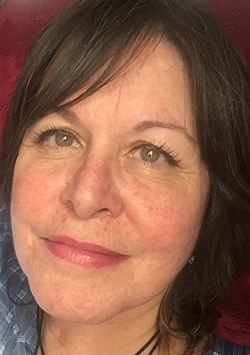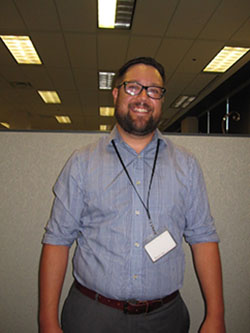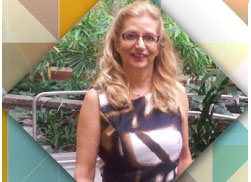Testimonials
As part of addressing mental health concerns openly, here are a few testimonials from employees working in the Department:
Lea Werthman
Life on the Continuum of Mental Health

I became a passionate advocate for mental health in 2008, when my best friend took her own life. I channeled all of my hurt and grief into a personal crusade to attack the stigma that had kept her silent. I became a champion for people with mental illness.
At the time, I didn’t identify what was happening to me as my own mental health challenge. This is how I-and the rest of the world-understood mental illness: as a binary thing. You either have it, or you don’t. I didn’t have it. My friend did, and it cost her her life.
My passion for mental health advocacy happily collided with the recent introduction of the Federal Public Service Workplace Mental Health Strategy. This strategy is helping to reframe all kinds of conversations about mental health, organizational culture, performance management and human resources. I have been honoured to take on the role of Mental Health Champion for the Citizen Service Branch.
The Mental Health Continuum: a transformational concept
In the old way of thinking, mental health was seen as a binary thing-we were either "healthy" or "ill." In the Mental Health Continuum, I found my "aha!" moment as a change agent-and in my own mental health. Clearly, we all live in a state of flux, somewhere along a continuum between the two extremes of "healthy" and "ill."
Most of us-we hope-live on the healthy side. But life is tough. Sometimes it’s brutal. With this new understanding, it’s clear we have to support people so they can go through their "reacting" and "injured" stages and come back to "healthy"-just as we have a responsibility to support someone who is physically ill or injured.
My story
Last Thanksgiving, my husband asked for a separation after 13 years of what I thought was the perfect marriage. My world tilted, and I fell into a big pool of crippling sadness. Immediately, I talked to my director. I contacted the Employee Assistance Program. I saw a therapist. I cried, I raged at the traffic, I wasn’t sleeping well and I began to worry that, fight as I might, I was becoming "ill."
But the Continuum allowed me to see myself differently. Instead of seeing myself as "broken" or "ill," I now know that I am reacting to a jarring change. I may even be dipping into "injured" now and then-and that’s ok. Sometimes I get a cough. Sometimes my arthritic knee hurts. It’s just another moment on a continuum of wellness.
I am immensely grateful that I have an amazing director who gives me the space I need to do what I need to do first: take care of myself. ESDC’s Workplace Mental Health Framework empowers me to ask for that help. Instead of going off on months of disability leave, I am working, supported by my office family, and getting through this.
I will not be defined by the sadness I am feeling. Instead, I will use this experience to share my story with you about our life on the continuum.
D’Arcy Gauthier

My name is D’Arcy and I am an alcoholic and addict. This is normally how I introduce myself at AA meetings and discuss the topics picked out at the meeting.
My story is similar to that of many people — many people who you may not realize struggle with addiction. Growing up, I was a very insecure child, always trying to please those around me in order to be liked and respected. I experienced the anxieties most teenagers suffer: I wanted to be good-looking, liked by girls and wanted everyone to like me. I also aspired to have a career I loved, to marry a woman I loved even more and to be the best dad I could ever be.
At the age of 14, I had my first drink and I felt this sudden peace. All my anxieties seem to disappear (once I got over the burning sensation). What I did not realize was that was the moment that would dictate the rest of my teenage and adult life. At the age of 19, I met a woman. We dated, moved in together, talked about our future together. However, I was incredibly unhappy and felt that this was the best I could achieve. In short, I settled. I was finding that my alcohol consumption had skyrocketed. I gained over 70 pounds. I turned to drugs. I engaged in things that I am not proud of and will probably never feel comfortable talking about. But the drugs and alcohol were my escape to help me forget I was likely going to marry someone I could never truly love.
At 27, I finally had the courage to leave that relationship. Things got worse. What I had done to make myself happy, ended up making me feel more alone and depressed. Suicide was on my mind. In order to calm those dark and sinister voices, my alcohol and drug consumption went up. I could no longer function without the effects of drugs and alcohol.
Several months after turning my life upside down, I started with the public service in the Employment Insurance call centre. I met my best friend, who I eventually married. Our future together was so full of hope and potential. But I could not shake my addiction. I always thought I could quit when I wanted— turns out I was incredibly wrong. When I met my wife, I could not admit I was an alcoholic or drug addict. I just passed it off as being a guy who loved to party and drink at home, alone if necessary.
I had what I had wanted as a teenager — career and marriage — but it still was not enough to save me. I continued to deny I was addicted. I took medication for depression. Then for bipolar disorder. I was institutionalized three times in a matter of 15 months for suicidal thoughts and addiction. I had taken unpaid sick leave several times, I was seeing an Employee Assistance Program (EAP) appointed counselor, and I was under the care of a psychiatrist. I was taking six different antidepressants and antipsychotics, I had a kidney removed, I suffered high blood pressure and I smoked, drank and did drugs. I was a ticking time bomb.
I was through with living. I had contemplated suicide on several occasions but could not go through with it. Continuing in my addiction was my way of taking my life away. I knew that if I continued, eventually I would just never wake up.
Finally in August 2015, I had enough. Well, my wife had had enough. It was either I give up or I seek help for my addiction. I enrolled in treatment and 35 days later, I came out a new man, full of hope. I’m celebrating one year of continuous sobriety on August 26. I have achieved this with a lot of work, regularly attending AA meetings, and the care and support from those around me, especially my loving and caring wife. I have no fear of telling people of my addiction struggles because I know it really helps me in my recovery to identify and connect with other addicts. Sharing helps.
I am incredibly encouraged that the employer and union are making headway in creating a mentally safe workplace. If it were not for my team leader at the time, my manager in the call centre, the EAP and the Joint Learning Program workshop, I would not be here today sharing my story
Suzanne Morin Blanchard
The Effect Mental Illness Has on Loved Ones

When mental illness strikes a loved one, it is shared amongst the family. Living with a loved one such as a parent, sibling, spouse or child who suffers from mental illness can have a negative impact on our own well-being. The stress and fatigue are often carried into the workplace and seeking support for ourselves is critical.
Because of the stigma attached to mental illness and fear of being labeled, my loved one Jamie[1] never received proper treatment. After many years of persuasion, Jamie finally sought counselling. Unfortunately, Jamie never received a full diagnosis or completed a proper source of treatment.
Jamie’s moods would shift without warning, experiencing outbursts of anger and abusive behaviors daily. Jamie was often tormented by feelings of isolation and loneliness even though the support of loved ones was all around.
Trying to protect others from Jamie’s mood swings, all while keeping balance in a volatile environment, became my unspoken cross to bear. It consumed me and took a toll on my own well-being. I fell into depression and suffered from anxiety. It affected my personal and work life. I never shared my pain, especially at work. I wanted to give the illusion that everything was normal, so I suffered in silence.
I lost myself trying to help Jamie find a way out of the black hole of mental illness. In doing so, I allowed Jamie to rob me of myself. Silence is not always golden. Sometimes it becomes our dragon or demon to sleigh.
For my own well-being, I eventually had to make the difficult choice of walking away. I realized that instead of helping Jamie, I had become an enabler. It took a long time to overcome the battle scars I suffered and the guilt that I was feeling. When I realized that it was not a battle I could fight on my own, I sought counselling and got help to overcome the pain I felt.
When you can’t see the forest for the trees, it is sometimes difficult to make sense of what’s happening to you and around you, which makes it impossible to make healthy choices. Conversations have become more open on the topic of mental health; it is not something to be ashamed of anymore.
My advice for anyone living with a loved one who suffers from mental illness is to seek out help and support for yourself. Don’t go it alone! You need to help and take care of yourself before you can help anyone else.
[1] In order to protect this individual’s confidentially, a fictitious name is used.
Sue Spooner

My name is Susan, Susie or Sue Spooner. No matter what name I go by, I am a little nervous and a bit embarrassed to say I live with depression. It took years to admit this to myself, let alone other people, especially colleagues. I thought it was a sign of weakness, and it took me a long time to realize I needed help.
I remember trying to explain what I was feeling when I was younger, but people just dismissed it as being a teenage girl, a phase. Deep down I knew it was more, but I couldn’t explain it and certainly didn’t want anyone to know I had “depression”. From the outside I seemed like a very happy, normal girl. But on the inside I was not that person at all. Why couldn’t anyone see this? Why could no one see the tears behind my eyes, the pain I was feeling inside? It was because I didn’t talk about it.
I carried this into adulthood, and over the years I also developed low self-esteem and anxiety. When I would try to explain how I felt to family or close friends, I would get the typical response of: “What do you have to be depressed about? You have a great husband, great kids, a nice house, a good-paying job, a car to drive, food to eat…” The list would go on and on. Then I would just feel even worse, because they were right. What was I depressed about?
My depression didn’t start with something situational; it was a chemical imbalance. However, I didn’t know this at the time. Of course, this had an impact on my professional life. Now, I am in a place in my life where I can and will be helping my mental mind by recognizing I need help and opening up to others. I have colleagues who are supportive, the same way they would be with someone who lives with an illness such as diabetes or high blood pressure. I don’t discuss it at length in the workplace—I concentrate on my work. But I don’t hide anymore either. I have discovered that this works for me.
My name is Susan, Susie or Sue Spooner. No matter what name I go by, I am no longer nervous or embarrassed to admit that I live with depression. It is never too late to talk about it and take action.
To get help, start with a person and/or context that makes you feel safe and not judged. This is just a phone call away through our Employee Assistance Program. Symptoms of mental distress include isolating ourselves. Our thought processes lead us to believe there’s more danger than safety in others, but when we choose our support wisely, there’s more help around us than we imagine.
Visit the other pages of Mental Health in the Workplace section to find out more about available tools and resources and to share your thoughts on this initiative.
Should you wish to share a testimonial, please take note of the writing tips and procedures (PDF, 105 KB).